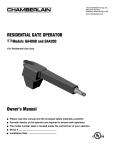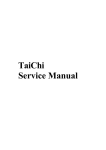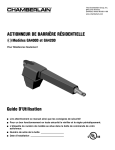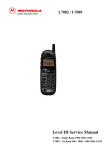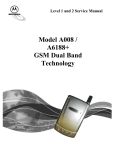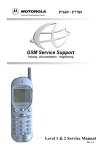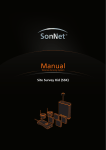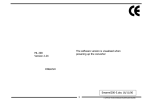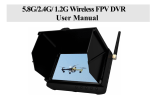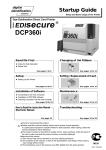Download Tai Shan
Transcript
Level 1 and 2 Service Manual V1.0 CONTENTS Page Number SECTION 1: GENERAL 1.1 Introduction 1.2 Motorola service policy for T189 in warranty 1.3 General Safety Information SECTION 2: T189 DESCRIPTION 2.1 Specifications of T189 2.2 T189 Overview 2.3 Connector Pinout 2.4 Talk time, Weight and Volume Matrix SECTION 3: FEATURE LIST 3.1 List of Features available 3.2 Phone Book 3.3 Call Related Features 3.4 Messages 3.5 Phone Set Up 3.6 Network selection 3.7 Call Meters 3.9 Accesory Set up SECTION 4: DISASSEMBLY & PARTS 4.1 Dissasembly Introduction 4.2 Recommended Tools 4.3 Disassembly Procedure 4.4 Assembly procedure 4.5 Exploded Parts diagram 4.6 Replacement parts SECTION 5: SIM CARDS AND SECURITY 5.1 Manual test mode 5.2 Live Sim Card 5.3 Personality Transfer 5.4 GSM Test Command 5.5 Identity and Security SECTION 6: REPAIR & TEST PROCEDURES 6.1 Repair introduction 6.2 Mechanical repairs 6.3 Basic modular troubleshooting 6.4 Repair Chart 6.5 Software Upgrade 6.6 Flexing 6.7 Testing on HP8922 SECTION 7: ACCESSORIES SECTION 8: SALES MODELS SECTION 9: GLOSSARY OF TERMS 9.1 List of Abbreviations 2.1 Specifications of T189 General Function Frequency Range GSM Frequency Range DCS Channel Spacing Channels Modulation Transmitter Phase Accuracy Duplex Spacing Frequency Stability Operating Voltage Transmit Current Stand-by Current Dimensions Size (Volume) Weight Temperature Range Transmitter Function RF Power Output Output Impedance Spurious Emissions Receiver Function RF Level RX bit error rate (100 k bits) Channel Hop Time Time to Camp Speech Coding Function Speech Coding Type Bit Rate Specification 880-915 MHz TX (with EGSM) 925-960 MHz RX (with EGSM) 1710-1785 MHz Tx 1805-1880 MHz Rx 200 kHz 174 GSM/374 DCS carriers with 8 channels per carrier GMSK at BT = 0.3 5 Degrees RMS, 20 Degrees peak 45 MHz GSM / 95MHz DCS + 0.10 ppm of the downlink frequency (Rx) Mid RateCharger: = 5.9V, +/-0.3V Battery Operating Voltage: 2.85V(Radio Shut Down voltage) To 4.2V Max) Typically 290 mA avg, Typically 10 mA 108mmx43mmx23.5mm (Leap Slim Battery) 85cc 95g with Battery -10C to +55C Specification 33 dBm + 2dB GSM/ 30 dBm + 2 dB DCS 50 ohms (nominal) -36 dBm from 0.1 to 1 Ghz -30 dBm from 1 to 4 Ghz Specification -102 dBm GSM / -100 dBm DCS < 2% 500 microseconds Approximately 5-10 seconds Specification Regular Pulse Excitation / Linear Predictive Coding with Long Term Prediction. (RPE LPC with LTP). 13.0 k bps Frame Duration Block Length Classes Bit Rate with FEC Encoding 20 ms 260 bits Class 1 bits = 182 bits. Class 2 bits = 78 bits 22.8 k bps 2.2 T189 Overview The T189 will incorporate many new features that were, in the past unavailable to the low cost products. These are: .Alarm RTC Vibrator Intergrated Headset 96 X 64 Graphics Display with 13 Soft Icons Single Lion Batteries 580mA Dual Band GSM 900 and GSM 1800 SIM toolkit V2.2.0 Fig 2.1 Mechanical pictorial Overview Antenna Lens Vol Up / Down Speaker Ports Headset Connector Keypad Screw Locations Antenna Auxiliary RF Test Port SIM Slot Batt Contacts Antenna Volume Buttons Headset Adapter Antenna Battery Cover 2.3 Connector Pinout 2.4 Talk Times, Weight, Dimensions and Volume Matrix Volume (cubic cm) ) Weight (grams) Talk Time (minutes) Standby time (hours) Dimensions (mm) With Battery type: 85 95g >=150-210 100-200 108mmx43mmx23.5mm (Leap Slim Battery 580mAh Lion Battery SECTION 3: FEATURE LIST Personal Numbers Find Entry by Name Enter Name Find Entry By Location Enter Location 1.Call Number 2.Modify Name or number 3.Erase name and number Add Entry Check Capacity 1.No memory restrictions 2.To SIM card memory Prevent access Last Ten Calls 1.Last Calls made 1.Call Number 2.Time and Date 3.Add to Phone memory 4.Add to SIM Card Memory Last Calls Received Erase all Numbers My phone number(s) Fixed dialing View fixed dial list Setup Fixed Dialing Show Services One-Touch Dial Setting 1To SIM memory 2 To Fixed Dial list Enter Pin2 1.On 2.Off 3.Edit Entry 4.Add Entry 5.Erase Entry Tower of Hanoi New Game Saved Game Best Score Bricks New Game Saved Game Best Score Baccarat New Game Saved Game Best Score Set Alarm One Time Daily Weekly Mon-Fri Mon-Sat Show Alarm Disable Alarm Edit Alarm Go To Next Alarm Call Voicemail Received messages Go to Next message Delete Message Return Call 1. 1.Send Message 2.Store Message Edit Message Reply to message Delete all messages Go to next message Outgoing Messages Send message Edit message 1.Send message 2.Store message Delete message On Cell broadcast Off 1.Channel Index 2.Delete all channels Channel List Language List English Automatic Message Settings 1.Voicemail Number 2.Service Centre 3.Expiry Period 4.Outgoing message type Store Message Message Editor Edit Message Send message 1. Line 1 2. Line 2 Select phone line Adjust Ring volume Set Ringer Tone Standard Tone : : Music Tone Set Ringer Tone 2 1.On 2.Off Ringer on or Off Phone Lock 1.On 2.Off Automatic Lock Lock Now Adjust Contrast Change Unlock mode Change SIM PIN2 Code Require SIM card pin 1.On 2.Off 3.Change SIM pin Code New security code Extended menus 1.On 2.Off English : : : Automatic Language Selection BoPo MoFo Stoke Entry Method Selection Battery saving mode Select Keypad tones Pin-Yin 1.On 2.Off 1.Normal Tones 2.Single Tones 3.No Tones Phone Status Ringer Only Ringer or Vibrate Vibrate Only Vibrate then Ring Continue to next page No Ring Or Vibrate iTAP TAP Mode 1.Status review 2.Master reset 3.Master Clear Continue from previous page Set Alarm Ringer Tone 1.On 2.Off Standard Tone : : Music Tone Set Message Alarm Tone Set Time and Date Set Time Set Date Show Time And Date 24h Set Time Format 12h SECTION 4: DISASSEMBLY &PARTS 4.1 Disassembly Introduction The T189 is held together by 6 screws, 2 uppermost and 4 within the battery casing. Ensure care is taken when removing the LCD from the main PCB as the flex is very delicate and can be easily damaged. Ensure that a properly grounded high impedance conductive wrist strap is used whilst performing any tasks during the disassembly and assembly of the unit Avoid stressing the plastics in any way to avoid damage to either the plastics or internal components. Many of the intergrated devices used in this equipment are vulnerable to damage from electro-static charges. Ensure that adequate static protection is in place when handling, shipping and servicing the internal components of this equipment. !! 4.2 Recommended Tools The following tools are recommended for use during the assembly / disassembly of the T189. • Anti-static Mat Kit - 0180386A82, includes: Antistatic mat 66-80387A95 Ground Cord 66-80334B36 Wrist Band 42-80385A59 • Plastic Bladed Tool SLN7223A • T6 Torx Driver 4.3 Disassembly Procedure The following set of diagrams will demonstrate the correct sequence and action required to disassemble the T189 . 4.4 Assembly Procedure Once the unit is disassembled and the repair is carried out, the unit must then be reassembled, this is carried out in the exact reverse order as the disassembly. !! CAUTION !! Many of the intergrated devices used in this equipment are vulnerable to damage from electro-static charges. Ensure that adequate static protection is in place when handling, shipping and servicing the internal components of this equipment. 1. Remove battery door by pressing down on 2. Remove Batteries latch and pulling back 3. Remove antenna by 4. Unscrew 6 retaining rotating anti-clockwise screws using T6 Torx driver find screw locations on page 4 5. Remove rear housing from unit. 7. Remove the rubber side panels the unit. 6. Slide plastic tool in between front housing and PCB and prise PCB out. 8. Remove Keypad 9. Remove alert speaker from front housing 11. Carefully lift the flip of the ZIF connector and remove the flex Note: The flex is very fragile. 10. Carefully prise display LCD from main board by releasing catches on each side of LCD frame 4.5 Exploded Parts Diagram 1 2 4 3 5 6 8 7 9 10 12 11 13 15 14 4.5Replacement Parts 1 TBD 2 3 4 5 6 7 8 9 10 11 12 13 14 15 Front Housing Rear Housing Battery cover Vibrator Antenna Number Keypad Mylar Dome LCD ASSY LCD Lens Mic & Grommet Speaker earpiece Side Key Power Key Screw SECTION 5: SIM CARDS AND SECURITY 5.1 Manual Test Mode The GSM Motorola T189 is equipped with a manual test mode capability. This capability allows service personnel to take control of the unit, and by entering certain keypad commands, make the unit performs desired functions. To enter the manual test command mode, a GSM / DCS mini test sim (Part No 8102430Z04) must be used. The test sim is inserted into the SIM slot in the side of the phone (See figure 6.1), the battery should then be inserted and the unit powered on. The # button should then be pressed for approximately 3 second until ‘test’ appears on the display, and the correct commands must then be followed. Figure 6.1 SIM Card insertion 5.2 Live Sim Card A SIM (Subscriber Identity module) card will be required to access the existing local GSM / DCS cellular network, or remote networks when travelling. (If the roaming agreement has been made with the provider.) The SIM card contains all the data necessary to access GSM services, and also: • The ability to store user information such as phone numbers etc… • All information required by the network provider to provide use to the network 5.3 Personality Transfer No personality transfer available on this product. 5.4 GSM Test Commands This is a list of Level 1 and 2 Test commands available to T189 Table 5.1 Test commands Key Sequence #(hold down for 2 seconds) 01# 07x# Test Function/Name Enter manual test mode Exit manual test mode Mute RX audio path 08# 09# 10# 15x# 16# 19# 20# 36# 37# 38# 39# 43x# 51# 52# 54X# Unmute RX audio path Mute TX audio path Unmute TX audio path Generate tone Mute tone generator Display S/W version number of Call Processor Display S/W version number of Modem Initiate acoustic loopback Stop test Activate Mini SIM Deactivate Mini SIM Change audio path Enable sidetone Disable sidetone Show Service Indicator LED 0 - Off / 1 – Red / 2 – Green / 3 – Amber (Flip must be Closed) Initialize non-volatile memory Display security code Modify security code Display lock code Modify lock code Display IMEI DCS / GSM mode Display all display pixels 57# 58# 58xxxxxx# 59# 59xxx# 60# 980# / 981# 99# 15XX# 91 Constant Ringer 36XX# 0 or Omitted 1 2 Full Rate Enhanced Full rate Half Rate 5.5 Identity and Security Each Motorola T189 will be labelled with various number configurations. The following information describes what these configurations mean. MSN The mechanical Serial Number (MSN) is an individual unit identity number and will remain with the unit throughout the life of the unit. The MSN can be used to log and track a unit on Motorola’s EPPRS system. The MSN is divided into 4 sections. IMEI The International Mobile station Equipment Identity (IMEI) number is an individual number unique to the PCB and is stored within the unit’s memory. The following figure gives a description of the make up of this number. Some other label number configurations that will be present will be: -XCVR NUMBER: Identifies type of product. i.e. T189 (Usually SWF number) PACKAGE NUMBER: Determines type of equipment, mode in which it was shipped and language with which it was shipped. SECTION 6: REPAIR AND TEST PROCEDURES 6.1 Repair Introduction The T189 is divided into 3 main sections when it comes to part replacability: The Flip which contains the speaker,battery connections, RTC battery and Vibrator. The housings that contain the main PCB which contains RF / Logic circuitry. The third component is the the keypad and Display Assy. If the RF / Logic board is required to be changed then a full service tranceiver should be ordered as there is no replacement PCB available. Also a personality transfer would be necessary. 6.2 Mechanical repairs Assembly replacement level troubleshooting and repair of the T189 is limited to isolation and replacement of the main mechanical parts only (See Exploded parts diagram and associated parts list) 6.3 Basic Modular Troubleshooting The troubleshooting information in Table 2 shows some typical malfunction symptoms, and for the corresponding verification and repair procedures refer to the disassembly instructions located in the disassembly section of this manual. (Section 5). NOTE Defective Logic/RF assemblies must be replaced with pre-tested, pre-phased assemblies 6.4 Repair Chart Table 2. GSM T189 Cellular Telephone: Troubleshooting and Repair Chart. (Assembly Replacement Level). SYMPTOM Personal telephone will not turn on or stay on PROBABLE CAUSE a) Battery pack either discharged or defective Battery connectors open or misaligned. VERIFICATION AND REMEDY Replace batteries with known good cells. Power unit on. If unit powers on OK replace batteries. If battery is not at fault, proceed to b. b) c) Logic/RF Board Assembly Defective. d) Display circuit failure 2. Personal telephone exhibits poor reception and/or erratic operation (such as calls frequently dropping, weak and/or distorted audio, etc.). a) Antenna is defective b) Logic/RF Board Assembly Defective. 3. Display is erratic, or provides Partial or no display. a) Mating connections to / from Display PCB. b) Display Module is Defective. Visually inspect the battery connectors on the rear housing top and bottom. Check for bad alignment or dirty contacts. Re-align, clean and, if necessary, replace the rear housing. If battery connectors are not at fault, proceed to c Remove the Logic/RF Assembly. Substitute a known good assembly and temporarily reassemble the unit. Depress the PWR button; if unit turns on and stays on, disconnect the dc power source and reassemble the telephone with the new Logic/RF Board assembly. If unit does not power up proceed to d) Disassemble unit and remove LCD module and insert known good module. Insert Battery and depress PWR button. Ensure unit stays on, if OK reassemble unit in new housing assembly Check to make sure that the antenna is properly inserted into the front housing. If OK, substitute a known good antenna. If the fault is still present, proceed to b. Replace Logic/RF Assembly (refer to symptom 1c). Verify that the fault has been cleared and Re-assemble the unit with the new PCB. Dissasemble unit, and remove display module from main PCB, check connector for any signs of corrosion or damage. If damaged proceed to c) Substitute a known good Display Module onto the suspect main board and connect to DC Pwr supply depress PWR and ensure display is now c) Defective. Logic/RF Board Assembly correct, If Ok rebuild unit with new Display assembly. If display assembly is not at fault proceed to c. Replace Logic/RF Assembly (refer to symptom 1c). Verify that the fault has been cleared and Re-assemble the unit with the new PCB. SYMPTOM 4. Incoming call alert transducer audio, distorted or volume is too low. PROBABLE CAUSE a) Faulty alert Transducer b)Main RF / Logic PCB defective 5. Personal telephone transmit audio is weak, (usually indicated by called parties complaining of difficulty in hearing voice from personal phone). a) Microphone connections to the main RF / Logic board are defective. b) Microphone defective b) Logic/RF Board Assembly defective. 6. Personal telephone receive audio is weak and/or distorted. (From speaker) Dirty Contacts / Misalignment of contacts or faulty speaker. c) Antenna assembly is defective. d) Defective. Logic/RF Board Assembly VERIFICATION AND REMEDY Replace Alert Transducer from rear housing refer to disassembly procedure.If not Alert then proceed to b) Replace Logic/RF Board Assembly (refer to symptom 1c). Verify that the fault has been cleared and re-assemble the unit with the new PCB. Gain access to the Microphone as described in the DISASSEMBLY instructions in this manual. . Check connections. If connector is faulty proceed to c if the connector is OK, proceed to b. Gain access to microphone .Disconnect and substitute a known good Microphone. Place a call and verify as heard by called party. If good, re-assemble unit with new Microphone. If Microphone is not at fault, re-install original Microphone and proceed to c. Replace Logic/RF Board Assembly (refer to symptom 1c). Verify that the fault has been cleared and re-assemble the unit with the new PCB. Ensure pads on PCB are clean and that speaker contacs are sat almost vertical to each other. If Ok replace with known good speaker and check for call quality. If still poor proceed to c) Attempt a re-phasing of the unit and recheck the symptom. If symptom is the same but unit re-phases correctly, check to make sure the antenna connector is correctly soldered to the main board and that the antenna is fitted correctly. If ok, substitute a known good antenna assembly. If this does not cure the fault, re-install the original antenna then proceed to d). d) Replace Logic/RF Assembly (refer to symptom 1c). Verify that the fault has been cleared and Re-assemble the unit with the new PCB. 7. Personal telephone will not recognize/accept SIM card a) SIM card defective Initially check that the contacts on the card are not dirty. Clean if necessary, and check if fault has been eliminated. If the contacts are clean, insert a Known good SIM card into the unit. Power up the unit and confirm whether or not the card has been accepted. If the fault no longer exists, the defective SIM card should be replaced. If the SIM card is not at fault, proceed to b. d) Logic/RF Board Assembly Defective. SYMPTOM 9. Internal Charger not working PROBABLE CAUSE a) Batteries faulty Faulty charger circuit on main board defective Replace Logic/RF Board Assembly (refer to symptom 1c). Verify that the fault has been cleared and re-assemble the unit with the new PCB. VERIFICATION AND REMEDY Replace suspect batteries with known good items. Insert charger and ensure battrey charging icon flashes if OK, replace batteries if batteries still do not charge proceed to b) a) 10. No / Weak audio when using a) Headset not fully pushed headset home still no audio proceed to b) b) Faulty Jack Socket / Defective PCB 6.5 Software Upgrade Replace Logic/RF Board Assembly (refer to symptom 1c). Verify that the fault has been cleared and re-assemble the unit with the new PCB. Fully ensure the ‘click’ is felt on the jack socket. If Replace Logic/RF Board Assembly (refer to symptom 1c). Verify that the fault has been cleared and re-assemble the unit with the new PCB. For information on setting up and equipment required for the flashing of software, contact should be made with the local technical support engineer. 6.6 Flexing For information on setting up and equipment for flexing, contact should be made with the local technical support engineer. 6.7 Testing on HP8922 SECTION 7: ACCESSORIES (TBD) SECTION 8: SALES MODELS (TBD) SECTION 9: GLOSSARY OF TERMS 9.1 List of Abbreviations Those marked ** are Motorola specific abbreviations. A Interface Interface between MSC and BSS A3 Authentication algorithm A5 Stream cipher algorithm A8 ciphering key generating algorithm AB Access Burst A-bis Interface between BSC and BTS ACCH Associated Control Channel ACSE Association Control Service Element AGCH Access Grant Channel AMPS Advance Mobile Phone System AOC Advice of charge ARFCN Absolute Radio Frequency Channel Number ARQ Automatic Request for retransmission ASIC Application Specific Integrated Circuit AUC Authentication Center AUT (H) Authentication BA BCCH Allocation BAIC Barring of All Incoming Calls BAOC barring of all Outgoing Calls BCC Base Transceiver Station (BTS) Color Code BCCH Broadcast Control Channel BCD Binary Coded Decimal BCU BTS Control Unit ** Bm Full-rate traffic channel BN Bit Number BS Base Station BSC Base Station Controller BSIC Base Transceiver Station Identity Code BSS Base Station System BSSAP BSS Application Part (DTAP and BSSMAP) BSSC Base Station System Control Cabinet ** BSSMAP Base Station Systems Management Application Part BSSOMAP BSS Operation and Maintenance Application Part BSU Base Site Controller Unit ** BTS Base Transceiver Station CA Call Allocation CBCH Call Broadcast Channel cc Call Control cc Country Code CC Cellular Cassette CCBS Completion of Calls to Busy Subscribers CCH Control Channel CCCH Common Control Channel CDMA Code Division Multiple Access CFS Call Forwarding on mobile Subscriber busy CFU Call Forwarding Unconditional CLIP Calling Line Identification Presentation CLIR Calling Line Identification Restriction CM Connection Management COLP Connected Line identification Presentation COLR Connected Line identification Restriction CONF Conference Call add on CSPDN Circuit Switched Public Data Network CUG Closed User Group CW Call Waiting DB Dummy Burst DBS Distributed Base Station ** DCCH Dedicated Control Channel DET Detach DFE Decision Feedback Equalizer DISC Disconnect DL Data Link (layer) Dm Control Channel (ISDN terminology applied to mobile service) Dm Signaling channel Dp Dialed Pulse DRCU Diversity Radio Channel Unit** DRX Discontinuous Reception DTAP Direct Transfer Application Part DTE Data Terminal Equipment DTMF Dual Tone Multi-Frequency (tone signaling type) DTX Discontinuous Transmission E erlang Eb/No Energy per Bit/Noise floor EC Echo Canceller Ec/No Ratio of energy per modulating bit to the noise spectral density EGSM Extended Group special Mobile EFR Enhanced Full Rate EIR Equipment Identity Register EIRP Effective Isotropic Radiated Power EMC Electromagnetic Compatibility EMX Electronic Mobile Exchange ** ETSI European Telecommunications Standards Institute FACCH Fast Associated Control channel FACCH/F Full rate Fast Associated Control channel FACCH/H Half rate fast Associated Control channel FB Frequency correction burst FCCH Frequency Correction Channel FEC Forward Error Correction FN Frame Number FR Full Rate FTAM File Transfer Access Management GCC Global Call Center GMSC Gateway Mobile Services Switching Center GMSK Gaussian Minimum Shift Keying GSM Group Special Mobile GSM MS GSM Mobile Station GSM PLMN GSM Public Land Mobile Network HANDO Handover HDLC High Level Data Link Control HLR Home Location Register HOLD Call Hold (Supplementary Service) HPLMN Home PLMN HPU Hand Portable Unit HR Half Rate HSN Hopping Sequence Number I Information (frames) IA5 International Alphanumeric 5 ID Identification IMEI International Mobile Equipment Identity IMM Immediate assignment message IMSI International Mobile Subscriber Identity IN Intelligent Network INDY Iridium 9500 handset ISC International Switching Center ISU Iridium Subscriber Unit ISDN Integrated Services Digital Network ISUP ISDN User Part IWF Interworking Function Kc ciphering Key Ki Individual subscriber authentication key LAC Location Area Code LAI Location Area Identification (Identity) LAPB Link Access Procedure ‘B’ (balanced) channel LAPDm Link Access Procedure ‘DM’ (mobile ‘D’) channel Lm Traffic channel (with capacity lower than Bm) LPC Linear Predictive Code LR Location Register MA Mobile Allocation MAH Mobile Access Hunting MAI Mobile Allocation Index MAIO Mobile Allocation Index Offset MAP Mobile Application Part MCC Mobile Country Code MCI Malicious Call Identification MD Mediation Device ME Mobile Equipment MF Multi-Frequency (tone signaling type) MLSE Maximum Likelihood Sequence Estimator MM Mobility Management MMI Man Machine Interface MNC Mobile Network Code MO Mobile Originated MO/PP Mobile Originated Point to Point messages MoU Memorandum of Understanding MRN Mobile Roaming Number MS Mobile Station MSC Mobile Services Switching Center MSCM Mobile Station Class Mark MSIN Mobile Station Identification Number MSISDN Mobile Station international ISDN number MSRN Mobile Station Roaming Number MT Mobile Termination MTP Message Transfer Part MT/PP Mobile Terminated Point to Point messages NAMPS North American-Advance Mobile Phone System NB Normal Burst NE Network Elements NET Norme European de Telecommunications NM Network Management NHC Network Management Center O&M Operations and Maintenance OACSU Off Air Call Set-Up OCB Outgoing Calls Barred OMAP Operations and Maintenance Application Part (previously was OAMP) OMC Operations and Maintenance Center OMCR Operations and Maintenance Center -Radio Part OMCS Operations and Maintenance Center -Switch Part OTA Over The Air Programming OSI Open System Interconnection PAD Packet Assembly Disassembly facility PCH Paging Channel PDN Public Data Networks PIN Personal Identification Number PLMN Public Land Mobile Network POTS Plain Old Telephone Service (basic telephone services) PSPDN Public Switched Packet Data Network PSTN Public Switched Telephone PTO Public Telecommunications Operator QOS Quality of Service RAB Random Access Burst RACH Random Access Channel RBDS Remote BSS Diagnostic Subsystem ** RBU Remote Base Station Unit (PCN) ** RCU Radio Channel Unit ** REC Recommendation REL Release RELP-LTP Regular Pulse Excitation - Long Term Prediction REQ Request RFCH Radio Frequency Channel RFN Reduced TDMA Frame Number RLP Radio Link Protocol ROSE Remote Operations Service Element (a CCITT specification for O&M) RXCDR Remote Transcoder Unit ** RXLEV Received signal level RXQUAL Received signal quality SABM Set Asynchronous Balance Model SACCH Slow Associated Control Channel SAPI Service Access Point Indicator (Identifier) SB Synchronization Burst SC Service Center SCCP Signaling Connection Control Part SCH Synchronization Channel SCP Service Control Point - an intelligent network entity SDCCH Stand-alone Dedicated Control Channel SDL Specification Description Language SFH Slow Frequency Hopping SIM Subscriber Identity Module SMS Short Message Service SMSCB Short Message Service Call Broadcast SND SeND SP Signaling Point SRES Signed RESponse (authentication) SS Supplementary Service SS System Simulator STP Signaling Transfer Point SYSGEN SYStem GENeration TA Terminal Adapter TA Timing Advance TCAP Transaction Capabilities Application Part TCH Traffic Channel TCH/F A full rate TCH TCH/FS A full rate speech TCH TCH/HS A half rate speech TCH TCP Transmission Control Protocol TDMA Time Division Multiple Access TE Terminal Equipment TMN Telecommunications Management Network TMSI Temporary Mobile Subscriber Identity TN Timeslot Number TRX Transceivers TTY TeleTYpe (refers to any terminal) TS Time Slot TUP Telephone Users Part UI Unnumbered Information frame Um Air Interface VAD Voice Activity Detection VLR Visited Location Register VLSI Very Large Scale Integration (IC) VPLMN Visited PLMN XC Transcoder XCDR Transcoder ** 3PTY Three party service Tai Shan DUAL BAND 1 Tai Shan DUAL BAND 2 Tai Shan Product Features *Platform *Dual *Full multiple forms/looks band CSM900/1800 matrix 96x64 graphics display with 13 soft icons *Integrated headset jack *Side Mounted Volume Switches *SIM toolkit *Microbrowser (UP 3.1 ) Capable 3 Tai Shan Product Features * * * * Size 108mm x42 mm x18 mm ( 120 cc ) Weight 120 g Talk Time 150--210 min Standby 100 --200hours 4 Tai Shan Design Approach * * * * * * * * 3.6 V Platform 3.6 V LDMOS PA Application VCO Modules Front End IC No Accessory Connector Stacked Flash Memory/SRAM Individual Battery Cells vs.. Battery Pack Leap charge circuit 5 Tai Shan The main updates based on shark Phone Book: 100 phone memory, SIM card memory (20+) Leap charging circuitry and software. Clock/Alarm with battery backup. Vibrator. MMI refreshment Butt-plug circuitry migration from Leap WAP removed 6 Tai Shan The main updates based on shark WAP removed Games Calculator (To be confirmed) Edit / Send Ringer Tone via SMS SMS with CLI No personalized banners No quick access key (cd928 type keyboard) 7 Tai Shan DISASSEMBLY 1. Remove battery door by pressing down on clip and pulling back 2. Remove the three batteries 8 Tai Shan DISASSEMBLY 3. Press down and pull SIM card lid to right and lift. For removing pull horizontally to the left. 4. Unscrew all 6 screws 9 Tai Shan DISASSEMBLY 5. 6. Lift off back housing Prise off alert from back housing 10 Tai Shan DISASSEMBLY 7. 8. Unscrew Antenna and remove Lift PCB out of front housing 11 Tai Shan DISASSEMBLY 9. 10. Remove Side Grip from front housing Remove keypad from front housing 12 Tai Shan DISASSEMBLY 11. Unclip display board latches at both sides of PCB and detach carefully 13 Tai Shan DISASSEMBLY 12. Lift hinge from ZIF connector and remove carefully flex-print 14 Tai Shan DISASSEMBLY 13. bottom side 14. top side 15 Tai Shan Y200, 26Mhz crystal U301 TX VCO J604 Battery CONN l U200, Magic IC J803 SIN CONN J600 Ext CONN Q370 TPA J300 RF CONN U350 PAC U800 White Cap U702 SRAM U701 Flash ROM U900 GCAPE 16 Tai Shan U432 Front end IC J510 Buzzer FL472 Filter J50504 Headset Jack U905 Back up battery FL490 400Mhz Filter U253 3U253 RX VCO J902 Display CONN LED LED 17 Taishan level 3 debug issue30/11/2000 Dual Band Taishan Dual band level 3 debug Version: 1.0 Prepared by Tony Zhang Date: Nov , 30 , 2000 Approved by _____________________ Total Pages: 19 - MOTOROLA INTERNAL USE ONLY - Shark level 3 debug issue31/11/2000 REVISION HISTORY Version Date Name Reason 1.0 23/12/1999 Fabrizio Alba First release - MOTOROLA INTERNAL USE ONLY - Dual band Taishan level 3 debug rev 1.0 lunedµ 20 dicembre 1999 Supply phone by Buttplug Leap Slim Li-ion battery code SNN5520A and check following tests sequence Does phone power up correctly ? For any page see electrical diagram equivalent NO Taishan test sequence Go to " no power up " on pag. 03 YES Does phone draw a lot of current ? YES ON FUTURE NO Does display works correctly? NO Go to " no display " on pag.11 YES Does backlight works correctly? NO Go to " no backlight "on pag.11 NO Go to " no keypad " on pag.12 YES Does keypad works correctly? YES Does phone shows "phone failure see supplier ? YES ON FUTURE NO go to " 1 " PAG 02 - MOTOROLA CONFIDENTIAL PROPRIETARY - Page 1 Dual band Taishan level 3 debug rev 1.0 lunedµ 20 dicembre 1999 "1" Taishan test sequence Connect phone to HP 8922 (active cell) Does phone go into service at -102dBm in GSM/DCS mode? NO Go to " no rx GSM/DCS " on pag.05 NO Go to " no tx GSM / DCS " on pag.07 YES Does phone initiate a call on GSM/DCS mode? YES Make a phone call from analyzer Is ringer tone audible ? NO YES Go to " no alert " on pag.12 Answer call Is audio tx working correctly? NO Go to " no microphone " on pag.14 YES Is audio RX on speaker working correctly? NO YES Go to " no audio on speaker " on pag.13 Insert headset on properly connector Are audio TX & RX working correctly on headset? NO Go to " no TX/RX audio on headset " on pag.14/15 YES Does internal charger and vibrator work correctly ? NO Go to No charger page 16 no vibrator page 17 YES Not fault found - MOTOROLA CONFIDENTIAL PROPRIETARY - Page 2 Dual band Taishan level 3 debug rev 1.0 lunedµ 20 dicembre 1999 note: all the signal & voltage present in this procedure has to be clear and at correct level ; compare them with a good pcb NOTE: check if any components mentioned is correctly positioned , has not dry joint and is not damaged . If all is ok replace it . If problem is still the same send BOARD IN htc. NO POWER UP Supply phone using Ext_B+ (~4.5V) on Butt-plug YES and check if phone power up correctly NO set power supply generator to 4 Vcc and check if phone power up correctly YES Check Ext_B+ from J600 to CR903 if OK Check CR903, Q905 and NOTE1 or faulty. NO Make a short on W.D. line on R941 side ( near C913 ) AND CHECK FOLLOWING FOLTAGES: -V_BOOST = 5,6 V on C913 -V1 =5V on C906 -V2 =2,8 V on C939 (R905)-V3 = 1,8 V on C909 -SR_VCC = 2,8 V on R722 -VRef =2,8 V on C919 SEE TIMING SEQUENCE on Pag. 16 , 17. NO For V_BOOST issue check L901 , C980 , C970 , C981 , CR 902 , C913 for other voltages issues check any line for short or different resistence ( compare with a good one ). YES Does 26 MHz clock is present on L220 ? YES Go to " 2 " on pag. 03 NO Check Y200 , C220 , L220 for missing , dry joint or faulty , check also for " VRef " voltage presence = 2,8 V on C213 , if not ok check line between C919 & C213. Finally check on C215 for "RF_V2 " voltage = 2,8 V presence and for " RF_V1 "voltage = 2,8 V on C217. - MOTOROLA CONFIDENTIAL PROPRIETARY - Page 3 Dual band Taishan level 3 debug rev 1.0 lunedµ 20 dicembre 1999 NO POWER UP "2" Does " MAGIC 13 MHz " clock is present on TP 200 or C817 ? Check for 13 MHz frequency presence on CR248 , if not ok check any components surround it for missing , dry joint or faulty ; check also V1_SW = 5 V presence on R234 ( it comes from Q913 ) . If all is ok probably U200 faulty. NO YES Does " GCAP_CLK 13MHz " is present on TP 823 or C825 ? Check following voltages before replacing U800: 2,8V=VDSS on R813 2,8V= VCC_MEMIF on R819 2V=VDD on R823 2V = VCCA on R825 NO YES Is reset voltage at 2,7 V present on C820 ? NO REPLACE U900 YES Is CE0 ,flash ic chip enable present on TP 824 ? NO Check for V2 = 2,8 V presence on C700 , C703 ,if they are ok replace U701 YES Is CE2 , ram ic chip select present on TP 825 and CE3 on TP 826 ? NO YES Check for U702 power supplies SR_VCC on C701 , R722, if not ok replace U900 , else replace U701. HTC - MOTOROLA CONFIDENTIAL PROPRIETARY - Page 4 Dual band Taishan level 3 debug rev 1.0 lunedµ 20 dicembre 1999 Connect on J300 connector an RF generator , set frequency equal to 947,4 MHz level -30dBm . Set pcb in test mode and digit RX test command 450062# Is IF at 400 MHz frequency present on C498 at correct level ? NOTE: check if any components mentioned is correctly positioned , has not dry joint and is not damaged . If all is ok replace it . If problem is still the same send BOARD IN htc. note: all the signal & voltage present in this procedure has to be clear and at correct level ; compare them with a good pcb Go to " A " on pag .06 NO NO RX GSM/DCS YES Is RX_LO at 800 MHz frequency present on CR249 ? NO Check Q203 for correct bias :base = 1,7 V;collector= 2,7 V; emitter = GND .check also for any faulty on CR 249 and components surround it YES Check for data presence on: - R299 BDR - R299 BFSR - R287 BCLKR Note: digit 450062# for every point of measure NO NO YES NO With PCB in stand by check for data presence on SPI BUS: TP 205 TP 206 YES Does RX ACQ signal works correct whenever you digit 450062# test command , check this on TP "RX_ACQ"? See receiver timing below YES Check U200 for faulty Problem could be U800,try to resolder it,after replace component. - MOTOROLA CONFIDENTIAL PROPRIETARY - Page 5 Dual band Taishan level 3 debug rev 1.0 lunedµ 20 dicembre 1999 A NO RX GSM/DCS Have you same issue also using DCS RX WAY ? set RF generator at 1842,8 MHz and digit 450700# test command. NO Is RF signal (digit 450062# ) at 947,4 MHz present on FL 472 pin 2? YES NO Check C472 , C473 , L471 for missing or dry joint ,else check C484 , C486 , L485 , L482 , R481. If all is ok replace U432 YES Is IF 400 MHz frequency present on U432 pin 3 & 4 ? YES Is IF 400 MHz frequency present on FL 490 pin 5? Check RF at GSM freq. presence on FL 472 IN, if it is ok replace FL 472 , else problem is FL 470 ( true only if you are sure that on DCS way everything is ok ). Check Q490 for correct bias : base = 0,8 V ; collector = 1,6 v ; emitter = GND . SW_VCC comes from YES U200 , else check any components surround it for faulty or missing NO REPLACE FL 472 (GSM ) FL 480 (DCS) REPLACE FL490 YES Is RF RX signal present on: U432 pin 18 AT 947,8 MHz frequency (GSM way digit 450062#) U432 pin 12 at 1842,8 MHz ( DCS way digit 450700#)? NO NO Is RF signal ( as before) present on FL472 in using GSM way or on FL 480 IN using DCS way way ? YES Is there same signal on FL 472 ( GSM WAY ) FL 480 ( DCS WAY ) NO Is there RF signal on C470 for GSM &DCS way? YES YES YES NO Check on U432 pin 7 for RX VCO presence at 1347,4 MHz for GSM or at 1442,8 MHz for DCS ,if ok check U432 for correctbias,else check U253 for faulty. Note: RX_VCO250 see on Q172 RX_DCS*GSM see on Q160 V_tuning,on pin 1, see R221,U200. SEE U432 DIAGRAM ON PAG.18 Check for faulty: J300,U100,Q110. TX_EN comes from U800,RX_EN comes from U800 , -5Vcc comes from U903 REPLACE FL470 - MOTOROLA CONFIDENTIAL PROPRIETARY - Check for GSM C472,C473,L471. for DCS C482 , C483 , L481 Page 6 Dual band Taishan level 3 debug rev 1.0 lunedµ 20 dicembre 1999 note: all the signal & voltage present in this procedure has to be clear and at correct level ; compare them with a good pcb NOTE: check if any components mentioned is correctly positioned , has not dry joint and is not damaged . If all is ok replace it . If problem is still the same send BOARD IN htc. NO TX GSM/DCS NOTE 1 : You can use this procedure for GSM way & DCS way. Whenever you have a signal with a simbol star ( * ) means that it is active low if you select this kind of way , while the same point of measure will be high for other way. Differences betwen GSM & DCS way are: TX_GSM*DCS used for adjust all RF TX way for GSM/DCS choise for any problem check on Q160 DCS_SEL comes out from U200 (or pin 2 U110) GSM_SEL comes out from U110 pin 4 -10 V comes out from U904. DCS_TX_VCO , GSM_TX_VCO for any problem check Q130 Connect on J300 connector an RF spectrum analyzer , set pcb in test mode and digit following test command: 110062# 1215# 40# for a test in GSM way. 110700# 1215# 40# for a test in DCS way. Check for RF signal presence at frequency = 902.4 MHz for GSM or 1747.8 MHz for DCS . RF IS PRESENT , NEVER MIND LEVEL BUT IS DIRTY RF IS PRESENT BUT IS LOW RF IS NOT PRESENT Is RF TX signal at GSM/DCS frequency present on U301 pin 4 ? YES Is RF TX GSM/DCS present on Q370 DRAIN? NO Go to " B " on pag.08 NO YES Check on U301: pin 3 DCS_TX_VCO see on Q130 , Q140. pin 8 GSM_TX_VCO see on Q130 , Q140. pin 10 SF_OUT see on C246 ( comes from U200 9. pin6 CP TX check for this Q310 , Q311 , U310 , U200 , R305 , R306 , R307. DM_CS , TX_EN , they comes from U800 V1_SW comes from Q913 Check: L365 , L325 , L326 , C397for missing or dry joint , else check for faulty Q110 , U100. -5V cc see U903 TX_EN , RX_EN comes from U800 - MOTOROLA CONFIDENTIAL PROPRIETARY - Page 7 Dual band Taishan level 3 debug rev 1.0 lunedµ 20 dicembre 1999 NO TX GSM/DCS "B" Is RF signal at 902,4 MHz ( GSM ) or at 1747,8 MHz ( DCS ) on Q331 collector YES Check Q370 for correct bias: drain = B+ voltages gate = 1,3 V see for this L370 , L336 , R370 presence ,else PAC IC bias on pag.09 NO Is RF GSM/DCS signal present on Q330 collector YES Check R304 , L331 , C315 , and Q331 for correct bias: REG B+ = 3,3 V voltage on collector ,see for this Q332 , Q333. 0,4 V on base see for this L333 , R302 , CR330 , R387,else PAC IC bias on page 09 NO Is RF GSM/DCS signal present on Q320 collector YES Check C1619 , R301 , CR320 , L320 , C326 , Q330 for correct bias: collector = 3,3 V REG B+ ,see for this Q332 , Q333; base = 1 V see R330 , PAC IC bias on pag. 09. NO Check Q320 for correct bias : collector = 2 V RF_V2 see on L322 , R300 base = DM_CS se on R326 , it comes from U 800 else be sure to have correct RF signal on U301 pin 1 ,if not ok go to " C " on page 07. - MOTOROLA CONFIDENTIAL PROPRIETARY - Page 8 Dual band Taishan level 3 debug rev 1.0 lunedµ 20 dicembre 1999 note: all the signal & voltage present in this procedure has to be clear and at correct level ; compare them with a good pcb PAC IC GND 1 14 RF_IN 2 13 GND 3 12 PAC_EN 4 EXC U350 NOTE: check if any components mentioned is correctly positioned , has not dry joint and is not damaged . If all is ok replace it . If problem is still the same send BOARD IN htc. NO TX GSM/DCS pin 4,14 PAC_EN comes from Q150 via Q350 ( TX_EN comes from U800 ) pin 8 , 9 , 10, 11 comes from U200 if not ok check : SPI BUS on TP 205 & TP 206 for data presence with pcb in stand by. PAC_EN = 4V 217 Hz TX KEY see on TP 209 DM_CS see on TP 208. NOTE: REFER DIAGRAMS BELOW & on pag. 10 FOR TIMING TX. 11 DET_SW 5 10 TX_KEY OUT 6 9 ACT 7 8 AOC TX POWER CONTROL ON U200 IC - MOTOROLA CONFIDENTIAL PROPRIETARY - Page 9 Dual band Taishan level 3 debug rev 1.0 lunedµ 20 dicembre 1999 note: all the signal & voltage present in this procedure has to be clear and at correct level ; compare them with a good pcb NOTE: check if any components mentioned is correctly positioned , has not dry joint and is not damaged . If all is ok replace it . If problem is still the same send BOARD IN htc. NO TX GSM/DCS MODULUS 2 TX TIMING on U200 - MOTOROLA CONFIDENTIAL PROPRIETARY - Page 10 Dual band Taishan level 3 debug rev 1.0 lunedµ 20 dicembre 1999 note: all the signal & voltage present in this procedure has to be clear and at correct level ; compare them with a good pcb NOTE: check if any components mentioned is correctly positioned , has not dry joint and is not damaged . If all is ok replace it . If problem is still the same send BOARD IN htc. CHECK CARD Probably U800 faulty Supply PCB using pcb test cable code AE20101903. Set pcb in test mode and digit 38# sim test enable and check on J803 sim connector : 1= GND 2 = SIM VCC 5V SEE u900 ( C906 ) 3 = NC 4 = RESET see CR905 , R940 5 = SIM I/O see R945 , U901 , R938. 6 = CLK see R940 YES NO Check, in order , U900 , U800 for faulty NO DISPLAY Replace display with a new one. Is still a display issue? YES NO END Check on J902 display connector for presence of: 1 =data DP_EN it comes from U800 2= 2,7 V RESET it comes from U900 3= data A0 see R716 for missing 4= data R_W it comes from U800 from 5 to 12 = data see on C1714 to C1720 13 = 2,7 Vcc V2 it comes from C939 14 = GND 15 = -5 Vcc it comes from U903. If all is ok probably U800 faulty. NO BACKLIGHT Supply pcb using pcb test cable code AE20101903; is a backlight issues only in any leds? YES NO Check on Display led's anode for ALRT_VCC = 3 V presence , if not ok check Q903 and conseguently U900 for faulty. Check also on Q907 gate for BKLT_EN = 2,7 Vcc , in this way on led's chatode there must be 1 V , if not ok check for R520 presence ,else replace Q907 Replace the faulty one - MOTOROLA CONFIDENTIAL PROPRIETARY - Page 11 Dual band Taishan level 3 debug rev 1.0 lunedµ 20 dicembre 1999 note: all the signal & voltage present in this procedure has to be clear and at correct level ; compare them with a good pcb NOTE: check if any components mentioned is correctly positioned , has not dry joint and is not damaged . If all is ok replace it . If problem is still the same send BOARD IN htc. NO KEYPAD Remove keypad membrane and check if here is any issues ( dirty , track , solder ) on key contacts from S501 to S522. Check also R500 , R501 , R502 for V2 = 2,8 Vcc presence, if all is ok probably U800 faulty. Note : for "VOL_UP " , "VOL_DOWN" keys check also CR502 , while for "PWR_ON " key check R508 for missing or unsoldered issue ,else problem could be U900. NO ALERT Supply pcb using "pcb test cable" cod AE20101903 , set pcb in test mode and digit test commands 432# = tone enabled on alert way ) 1513# (continuos tone ),4707# max volume . Check for "ALRT_VCC" = 3 Vcc presence on J510 alert pad and check for signal = 1,6 Vpp offset = 1,4 Vcc on J511 alert pad YES Check alert for faulty , else be sure you have not any intermittent problem ( check U900 for this ),or check for dirty on J510 , J511 alert pads. NO Check in order: ALRT_VCC presence = 3V on Q903 pin 1 , 2 , 5 , 6 , if not ok check on pin 4 for B+ presence .Note: because Q903 is positioned under test cable you are not able to check for ALRT_VCC presence on it,so you can check this on backlight leds anode. Check CR510 , C1723 , C1722 , C933 for missing , dry joint or faulty. Finally, only if you have not any issue on audio speaker, problem could be U900. - MOTOROLA CONFIDENTIAL PROPRIETARY - Page 12 Dual band Taishan level 3 debug rev 1.0 lunedµ 20 dicembre 1999 note: all the signal & voltage present in this procedure has to be clear and at correct level ; compare them with a good pcb NOTE: check if any components mentioned is correctly positioned , has not dry joint and is not damaged . If all is ok replace it . If problem is still the same send BOARD IN htc. NO AUDIO on SPEAKER Power on pcb using "pcb test cable " code AE20101903 reset pcb and check on J502 & J503 speaker contacts for presence , during power up sequence , of a signal 1 Vpp offset 1,5 Vcc NO YES NO Insert on J504 connector an headset jack ,is power on tone udible on speaker? NO NO Replace speaker on front housing Offset and audio are presents but low compared with a good one YES Check for 2,7 Vcc presence on VR977 without jack inserted and 0,6 Vcc with jack on; if not ok check for missing , dry joint or unsoldered issues on R976 , R977 , L1004 , VR 977 , J504 . Else problem could be U800. Set pcb in test mode and digit following test command: 481000# , 434# , 4707# ; is 1 KHz tone present on speaker ? important: remove jack on J504 connector YES END Check for VAG = 1,5 Vcc presence on C940 , if not ok check in order: C940 , C938 , C926 , C925 for any faluty If they are ok problem could be U900 You could have an intermittent problem , so check any components of speaker way for this (U800 , U900). NO Digit 432# test command ( enabled alert way for audio use ); is 1 KHz tone present on alert pads J510 = B+ , J511=tone ? YES NO Digit 434# test command , check on SPI AUDIO DIGITAL: TP 828 VCLK at 512 KHz TP831 RX DATA TP830 TX DATA TP829 VFSRX at 8KHz. If all is ok replace U900 ,else problem could be U800. Check for faulty , missing or dry joint on: R517 ,R518 , R519 ,CR500. - MOTOROLA CONFIDENTIAL PROPRIETARY - Page 13 Dual band Taishan level 3 debug rev 1.0 lunedµ 20 dicembre 1999 note: all the signal & voltage present in this procedure has to be clear and at correct level ; compare them with a good pcb NOTE: check if any components mentioned is correctly positioned , has not dry joint and is not damaged . If all is ok replace it . If problem is still the same send BOARD IN htc. NO AUDIO TX on microphone/headset Supply pcb using "pcb test cable " code AE20101903 ,set pcb in test mode, digit test command: 434# audio on speaker 36# loop back on 4707# max volume Check which way doesn' t works correctly. Note: if each way doesn't works check on U900 for PRESENCE OF " SPI AUDIO BUS " : Tp 828 CK 512 KHz , Tp 831 data Tp 830 data , Tp 829 8 KHz ck. If they are not presents check on Tp 823 or C825 for 13 MHz ck , if not ok problem could be U800, else U900. INTERNAL MIKE DOESN'T WORK. Check for "Mic bias" = 1,4 Vcc presence on C923 , if not ok check for dry joint , misssing or unsoldered issues on R927 , R926 , C934 , C927 ;if ok check for same issues on C923 , R925 , L927. Finally problem could be U900. HEADSET MIKE DOESN'T WORK. Check in order: _J504 "headset jack" for faulty or unsoldered pins. _0,6 V presence on R977with jack on and 2,7 Vcc with itself off , if not correct check for V2 =2,7 Vcc presence on R976 , else check R976 , R977 , L1004 , VR 977 for missing , dry joint or unsoldered issues. _L500 , C1520 , C510 , C931 , R930 , C927 , R928 , L928 for same issues. _Mic_bias = 1 Vcc presence on C931, if not correct ,check R957 for missing ,dry joint or unsoldered issues. - MOTOROLA CONFIDENTIAL PROPRIETARY - Page 14 Dual band Taishan level 3 debug rev 1.0 lunedµ 20 dicembre 1999 note: all the signal & voltage present in this procedure has to be clear and at correct level ; compare them with a good pcb NOTE: check if any components mentioned is correctly positioned , has not dry joint and is not damaged . If all is ok replace it . If problem is still the same send BOARD IN htc. Supply pcb using pcb test cable cod.AE20101903, set pcb in test mode and digit test commands: 481000# 1 KHz tone enabled 434# audio on speaker / headset way 4707# max volume audio Insert on J504 headset connector an headset jack and check if 1KHz tone is udible on headset speaker YES NO AUDIO RX on headset , speaker ok Check J504 , U900 for any intermittent issue NO Is SPKR- signal at 0,5 Vpp , 1,4 Vcc offset present on R1506? NO Check SPKR- line for track between R933 and R1506. Else , check for 0,6v presence on VR 977 with jack on and 2,7 V with jack off ,in this way problem can be " HEAD_INT " line faulty,check for this VR977 , R977 , L1004 ,J504. YES Check for missing , dry joint or unsoldered issues on: R1506 , C611 , R961 , C951 , C952 , L1005 , J504. - MOTOROLA CONFIDENTIAL PROPRIETARY - Page 15 Dual band Taishan level 3 debug rev 1.0 Taishan: NO CHARGER START YES Is thermistor problem ? (check it using gate22 processing test) Is there 2,7Volt on BATT_THERM terminal on pin 2 of J604 ? NO Check Q914 and U905 NOTE1 or Faulty. NO YES Put the phone in test mode and digit 500255# NO Without battery, Is there 2,7Volt on pin1 of U905 ? (with battery it must be 0Volt). Check U905 and Q908 NOTE1 or Faulty. NO Is there on pin3 of Q900 about EXT_B+ voltage ? Check R913 YES YES Check U800 NOTE1 or Faulty. NO Is there 0Volt on pin4 of Q900 ? Check U900 NOTE1 or Faulty. YES NO Is there about EXT_B+ voltage on pin4 of J604 Check Q900 NOTE1 or Faulty and J604 NOTE1. YES Check for intermittent problem. NOTE1 : check if any components mentioned are correctly positioned , have not dry joint and aren't not phisically damaged . - MOTOROLA CONFIDENTIAL PROPRIETARY - Page 16 Dual band Taishan level 3 debug rev 1.0 Taishan: NO VIBRACALL START Put the phone in Test mode and digit 1590# Is there 2,7Volt on pin1 of U501 ? NO Check U800 NOTE1 or Faulty YES Check U501 (there must be about 1,3Volt on pin4) and J5001/2 contacts. NOTE1 : check if any components mentioned are correctly positioned , have not dry joint and aren't not phisically damaged . - MOTOROLA CONFIDENTIAL PROPRIETARY - Page 17 Dual band Taishan level 3 debug rev 1.0 lunedµ 20 dicembre 1999 See timing sequence below for no power up issues on pag.03 - MOTOROLA CONFIDENTIAL PROPRIETARY - NO POWER UP TIMING SEQUENCE Page 18 Dual band Taishan level 3 debug rev 1.0 lunedµ 20 dicembre 1999 See timing sequence below for no power up issues on pag.03 - MOTOROLA CONFIDENTIAL PROPRIETARY - NO POWER UP TIMING SEQUENCE Page 19 Dual band Taishan level 3 debug rev 1.0 lunedµ 20 dicembre 1999 U432 (front end+mixer) - MOTOROLA CONFIDENTIAL PROPRIETARY - Page 20 Dual band Taishan level 3 debug rev 1.0 lunedµ 20 dicembre 1999 MAGIC IC U200 PACKAGE GCAP 2 IC U900 PACKAGE WHITECAP IC U800 PACKAGE - MOTOROLA CONFIDENTIAL PROPRIETARY - Page 21 RX MID CHANNELS GSM: CH 62 -- 947,4 MHz EGSM: CH 37 -- 942,4Mhz DCS: CH 700 -- 1842,8MHz A100 RX LOCAL OSCILLATOR A9 Osc. discrete circuty -5V 800MHz D8 PLL Q203 VB VA 4 2 GSM VA 1 J300 U100 6 5 3, 4 2 5 1 1 2 FL480 FL470 900-1900MHz 1 2 925-960MHz 1 1805-1880MHz 5 2 FL472 DCS VB B 5 10 C7 C6 C RF_V1 24 DCS_SEL B Q201 E E Q202 RF_V2 RXI RX RXQ SPI DEMODULATION C H1 B F1 PHASE DET 13MHz 5 4 C Q370 B C Q331 B C Q330 A3 1 6 U253 RX VCO RVCO_250 2 3 Q172 4 CR248 J9 SU PER F ILTER Startup Ref. 1 /2 PHASE DET to WhiteCap CLK_SELCT from WhiteCap REF. OSC. 200KHz AFC MAGIC_13MHz E2 Prog. Divider Divider H6 26 MHz 26MHz Y200 REF. A8 GP04 F9 GP02 C4 CC B Q320 VRef J7 PLL V1_SW 6 B CR320 MUX A1 B1 B+ RF_V2 C1 RX_DCS_*GSM ( CE ) MQSPI_CS1 LOGIC SPI G5 INTER H4 FACE J3 CONTROL ( SPI_CLK ) MOSPI_CLK1 ( SPI_DATA ) DX1 from WhiteCap RF_IN 2 TX VCO FRQ. RANGE EGSM: 880-915Mhz DCS: 1710-1785MHz DET PAC_EN 1, 3 TX VCO MID CHANNELS GSM: CH 62 -- 902,4MHz EGSM: CH 37 -- 897,4Mhz DCS: CH 700 -- 1747,8MHz SAT. 4, 14 10 12 9 11 DET_SW 1 U301 TX VCO 8 6 TX LOOP FILTER 10 3 PAC_EN GSM / DCS SELECT CIRCUIT DETECT_SW A5 AOC_DRIVE B6 SAT_DETECT SAT_DETECT B4 TX_KEY_OUT TX_KEY_OUT C5 GSM_TX_VCO RX_DCS_*GSM -5V DCS_SEL TX TXQ SPI GSM SERVICE SUPPORT GROUP 30.11.00 LEVEL 3 RF Block Diagram Rev. 1.0 ( SDTX ) BDX ( TX_CLK ) BCLKX G7 H8 PA CONTROL LOGIC CONTROL Page1 J4 RX_ACQ DM_CS TX_KEY from WhiteCap H5 RX SIGNAL PATH REFERENCE CLOCK TX SIGNAL PATH Orderable Part MAIN VCO SIGNAL PATH Non - Orderable Part Dualband Taishan Roger Hong, Pei Yuantao, Luo Yu J2 DCS_SEL AOC_DRIVE DCS_TX_VCO TXI MODULATION SF_OUT D CS_TX _VC O 7 U350 PAC GSM_TX _VC O Dual Band Taishan REG_B+ SF_OUT RX VCO FRQ. RANGE EGSM: 1325 - 1360Mhz DCS: 1405 - 1480MHz TX_EN Q333 to WhiteCap ( SDRX ) BDR J6 GSM: CH 62 -- 1347,4 MHz EGSM: CH 37 -- 1342,4Mhz DCS: CH 700 -- 1442,8MHz ( SDFS ) BFSR Divider 200KHz RX VCO MID CHANNELS B+ G9 G1 H2 D1, D8, F2 TX FRQ. RANGE EGSM: 880-915Mhz DCS: 1710-1785MHz F7 G8 SW_VCC B+ RX_EN A7 STEP ATT. C 7 16 C Q490 FL490 3 4 U432 FRONTEND IC 3 3 4 2,5,6 ( SCLK_OUT ) BCLKR 400 MHz RF_V2 RVCO_250 2 SWITCH Q110 TX_EN U913 MAGIC C8 CR249 RF_V1 SW ITCH RX_EN 1 REG. 5 TUNING VOLTAGES SIMPD0 V2 BATT_THERM_AD U905 IrDA_EN VIB_EN EXT_CHG_EN HEAD_INT_L CLK_SELCT TX_EN DM_CS TX_KEY RX_EN RX_ACQ RESET ( SDTX ) BDX ( TX_CLK ) BCLKX from / to MAGIC BCLKR ( SDFS ) BFSR ( SDRX ) BDR 15 PIN EXT CONN. J 600 DSC_EN 13 CPU K2 GND 5 1 3 10 15 ON / OFF 9 BATT_FDBK to J600 H10 B2 SENSE A2 B3 CNTL. D9 PA_DRV H9 HEADSET CON. SPKR V2 R976 R977 MAGIC_13MHz KBR0- KBR4 to WhiteCap KBC0-KBC4 -5V 1 5-8 Q938 KEYPAD PWR_SW from G CAP2 1-3 Q901 4 2 6-8 4,6 2 VREF STBY_DL V1 V2 Q909 Q904 3 Q900 DEEP SLEEP V1_SW BACK LIGHT ALERT_VCC from G CAP2 CIRCUIT B BKLT_EN from WhiteCap 7,8 CLK 2 SIM_I/O E 1 5 L901 J5001 J5002 VIBRA CON. 6 J803 SIM Con. 4 3 VSIM1 RX SIGNAL PATH PWR_SW STBY_DL V3 REG. B5 J5 V1 REG. A6 VSIM REG. C6 TX SIGNAL PATH VREF 2.775V,for Magic MAIN VCO SIGNAL PATH V3 1,8V, for WhiteCap V2 2.775V, for WhiteCap logic outputs, RAM, FLASH, EEPROM TUNING VOLTAGES V1 5.0V, for DSC Bus, Negative Voltage Regulator REFERENCE CLOCK VSIM1 3.0 or 5.0V, for SIM Card Circuit Orderable Part C5, B6 A10, C10 E1 1-3 4 U501 LS1_IN LS2_IN SIM_TX SIM_RX G9 VBOOST1 REG. 1 RESET Non - Orderable Part CR902 GSM SERVICE SUPPORT GROUP 30.11.00 LEVEL 3 AL Block Diagram Rev. 1.0 Dual Band Taishan V_BOOST1 Internal GCap use only (VSIM1, LS_V1) Roger Hong, Pei Yuantao, Luo Yu ALRT_VCC B+ C Q907 BATT+ EXT_B+ SR_VCC 4 1 -10V B10 ALRT HEAD_INT_L U903 2 1 CHRGC MAIN_FET VREF REG. V2 REG. H6 H7 K9 J9 V1 U904 B+ G4 Logic Control J504 4 ( WhiteCap ) VIB_EN C8 E18 A5 K6 14 4 15 ( -10V ) 5 K7 G6 K10 H8 ALRTOUT K1 GND R_W DP_EN_L D7 F8 ISENSE G_CAP2 SPR+ 1 U701 EPROM B3 EEPROM BATT_THERM_AD 1,2,5,6 4 13 2 V2 RESET INT. DIV. 4 MIC U902 B4 3 R913 J2 2 A4, E1, F5 R_W CE0 CE1 Q905 LEVEL J7 SHIFT J8 Interface Audio Codec Q902 MIDRATE_1 MIDRATE_2 D2 C2 11 12 UPLINK DOWNLINK V2 RESET BATT CON. GND For description of Midrate Charger 1 see document on: emeacs.fle.css.mot.com J604 2 4 3 B+ CHRG_EN BATT+ 4 BATT_SER_DATA CR903 4 F6 G5 C4 G5 3 ON_2 RESET 2 EXT_B+ U900 A1 DSC_EN_AD DOWNLINL_AD BATT_THERM_AD ISENSE STBY_DL BATT_SER_DATA D9 C7 D6 CHARGE E8 REAL TIME SELECT F10 CLOCK F7 SENSE D10 EXT_B+ SPR- Taishan MAN_TEST_AD GND GND GND F1 Y900 GCAP SPI AUDIO SPI 8 14 EXT_B+ 3 D0-D7 5-12 SRAM D9 B9 A7 B7 SPI INTERFACE A1 R_W B11 from Charger F5 EXT_CHG_EN CE3 TIMER B7 P4 D6, E1 B2 U702 CE2 C9 E10 H5 PB6 CHARGE L7 L6 SPI INTERFACE A0 V1-V5 CTM UART A5 INTERF. A6 J902 C702-C706 SR_VCC DSP DSC to MAGIC DATA BUS 32.768 KHz 4 B4 D4 A3 MAGIC SPI ADDRESS BUS I N T E R F A C E B6 B3 V3 M E M O R Y U800 B2 K1 C2 A1 N3 C1 A1 C1 E2 CTM E2 E1 E1 E3 MODULE E3 E4 E4 P2 P2 SERIAL INTER FACE V2 SPI INTERFACE GCLK BATT_FDBK WHITE_CAP GCAP_CLK 13 MHz RS232_TX 7 6 RS232_RX A9, A10, C5, K6, K10, M8, M11 A4 E9 SIM E7 F3 INTER B5 FACE LS1_IN LS2_IN SIM_TX SIM_RX VDDS VCC_MEMIF VDD VCCA C14, F10, G4, H4, K5, P13 DISPLAY H2, H1, H3 J5, J3, J2 KEYPAD K3 DISPLAY A11 INTERFACE RTC_BATT KBR0, KBR1, KBR2 to Keyboard KBC0, KBC1, KBC2 BKLT_EN to Display DP_EN_L ALRT_VCC to Backlight Page 2 Taishan Board Layout Draft 2000-12-12 Dual Band Taishan GSM SERVICE SUPPORT 2001.01.15 Level 3 Schematics Rev. 1.0 Dual Band Taishan 8464737E01_ Rev.0 Michael Hansen, Ralf Lorenzen-Scheil, Ray Collins Page 1

























































































